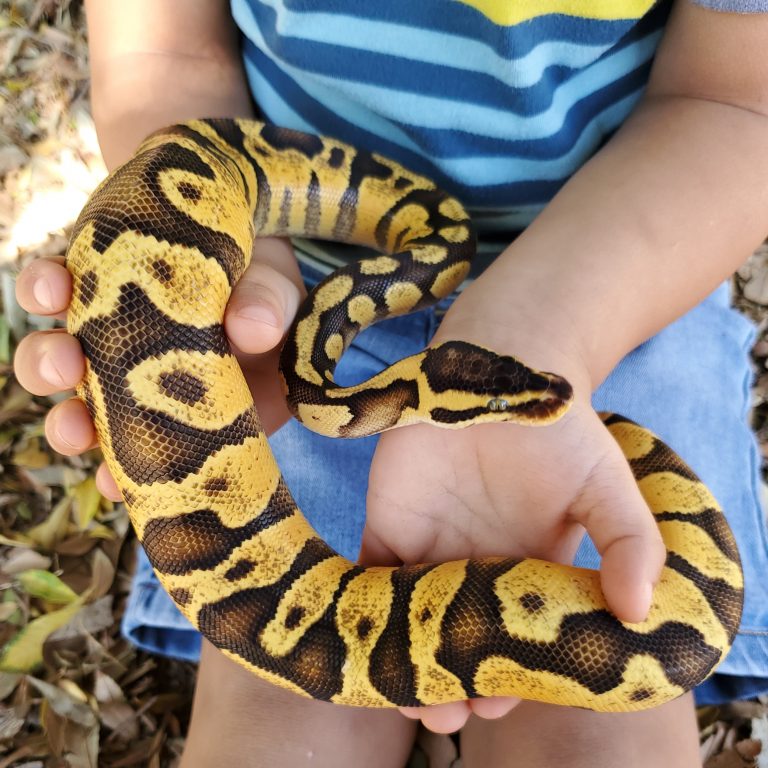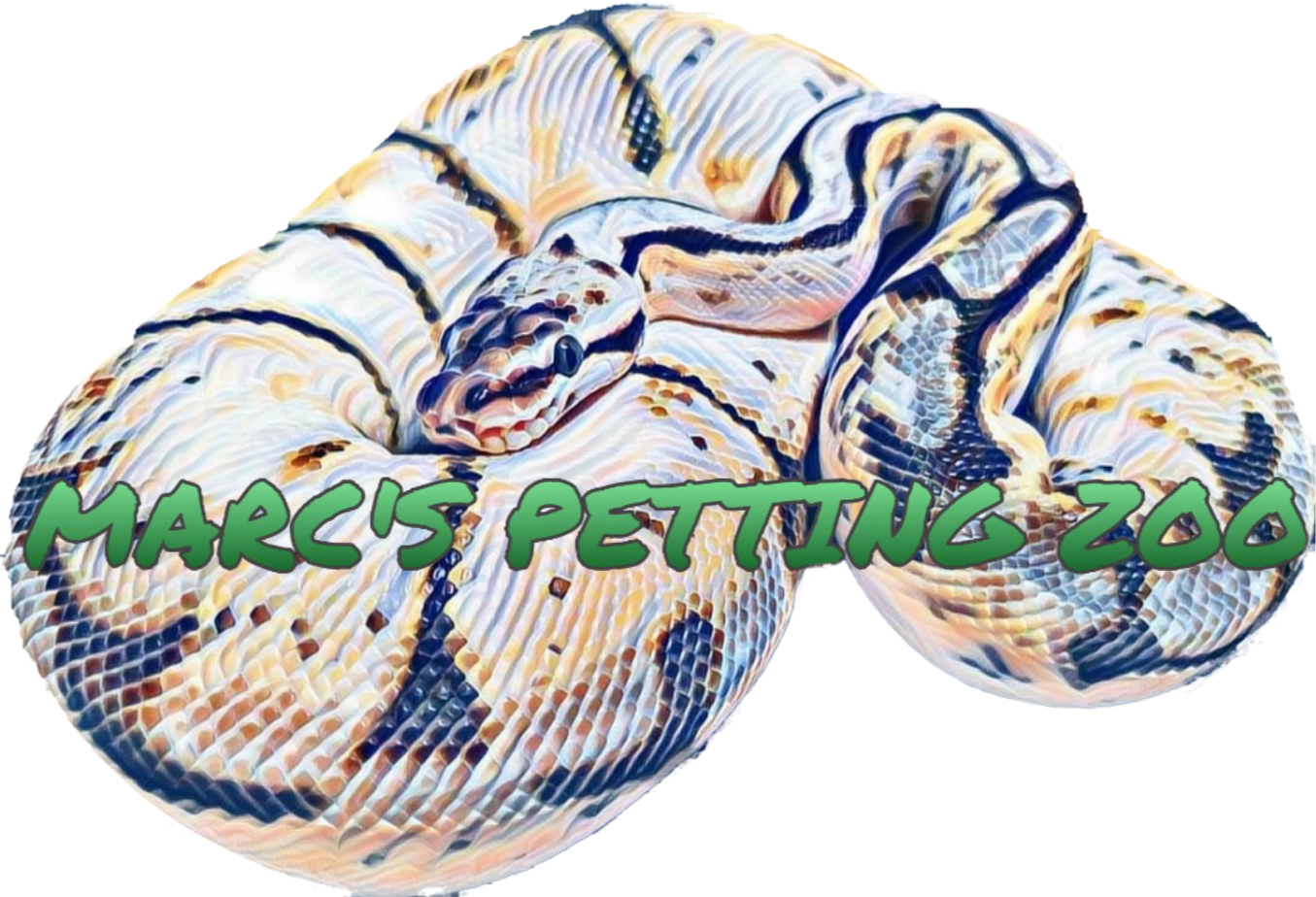
Ball Python Care Sheet
General Care: Ball pythons are good pets for beginners because they are fairly easy to care for. They can be housed reasonably inexpensively, their size is easy to handle, and they have the perfect temperament for beginner keepers. Ball Pythons need moderate humidity (around 50-60%), an ambient temperature of about 78°-80°F or 25°-26°C and a hot-spot of around 88°-95°F or 31°-35°C. You can monitor the ambient temperature and humidity with a thermometer and humidity gauge, and the hot spot can be automatically controlled with a digital thermostat. If you use a commercial heat mat, these mats have a built in cut off and only get to the temperature you need. You can use a temperature gun to check the temperature of the hot spot. You need a heat mat or heat tape (thermostat is recommended if using heat tape and required if you are using anything other than a glass enclosure) and a spray bottle to mist the cage periodically to increase the humidity. Ball pythons do not require UV light so the ambient light from the room is sufficient for lighting. The enclosure should be large enough so that your animal can thermoregulate and move away from your heat source should they want to cool off. Along with the temperature gradient and moderate humidity, your enclosure should also have a hide for your ball python to feel secure. Ball pythons instinctively hide to avoid predators in the wild and feel secure and safe if they have a good place to hide. Some ball pythons could become stressed and will not eat if they do not feel secure in their enclosure. Make sure the hide is not too big and is just about the same size as the snake. They tend to like to squeeze into tight spaces to feel more secure.
Enclosures: Since ball pythons like tight spaces, they do not require a very large enclosure. You can house your ball python in a rack system with a tub and heat tape or in a conventional glass terrarium with a commercial heat mat. If you go with a rack and tub setup you may not need a hide because your ball python can tuck in at the back of the tub and feel secure. If you go with a glass terrarium you will definitely need to provide your ball python with a hide.
Substrate: You have a few options with substrate as well. You can go with a naturalistic forest floor type substrate which will help with humidity retention if you live in a dryer climate, or you can go simple and use paper towels or newspaper.
Decorations and Accessories: For decorations, you can add just about anything to your enclosure. Any commercial plastic plants and decorations will work to add some flare to your enclosure. Plastic foliage can also provide additional hiding places for your ball python. You can also add skulls or other decorative hides so your snake can use it to hide in and it doubles as a decorative piece for your enclosure. Water bowls can be plain or decorative as well and you can find some that will be functional and decorative. If you pick branches or other decorations from outside make sure you bake them in an oven before you put it in your enclosure to kill any bugs and parasites that may be found in those decorations.
Feeding: Ball pythons eat rats. Before bringing home your ball python you should find a reliable source of rats. To start off, most hatchling ball pythons will only eat live pinky or fuzzy rats, but most are able to transition to frozen thawed. Hatchling ball pythons should be offered food every 5-6 days and adults can be offered food every 7-14 days. Older snakes have slower metabolisms and will eat larger prey items but may only eat every other week. You should feed your snake a prey item that is the same thickness or a little thicker than the thickest part of the snake. To prepare a frozen rat, you should place the rat into a ziplock bag and submerge the bag into a bowl of hot water to defrost. You may have to change the water a few times to get the rat defrosted and up to body temperature again. You should NOT microwave a rat to defrost it. This will cook the rat and make the bones of the rat hard, making it difficult for your snake to digest. You do not need to use a seperate enclosure for feeding your snake. A common fear is that the snake will strike every time you open it’s enclosure if that is where it is fed. If you spend time handling your snake, you shouldn’t have a feeding response every time you open the enclosure. Ball pythons are notoriously picky eaters. Some will refuse frozen thawed rats and only eat live rats. Some will go off food for no reason and start eating again randomly. It usually isn’t a cause for concern. However, if you notice significant weight loss or other signs of illness, you need to consult with your veterinarian.
Tank setup: Prior to bringing home your new ball python, you will need to ensure the snake’s enclosure is set up properly. It is important to make sure the enclosure’s temperature and humidity are correct before housing your new snake. Now to put all the pieces together! First, you should rinse out your enclosure with soap and water to remove any chemicals that may be in your enclosure. Next, add your heat mat or heat tape to the bottom of the tank. If you are using a thermostat you will want to attach your temperature probe directly to the heat mat between the heat mat or heat tape and your enclosure. Commercial heat mats will have a sticky side that you will use to stick to the bottom of your enclosure you should stick the temperature probe in the middle of the heat mat sticky side and then stick the heat mat to the bottom of the enclosure. if you are using heat tape instead you can use some aluminum tape to stick the temperature to the heat tape and you can use the same tape to tape the heat tape to the bottom of the enclosure. Then, add your thermometer and humidity gauge somewhere near the middle of your enclosure. Next, you should add your substrate. If you are using forest floor or reptibark or some other naturalistic substrate you should add enough substrate to cover the entire floor of the enclosure. Remember: the more substrate you add, the further the heat source is from your snake so you don’t want to add so much that it insulates the enclosure and does not provide the proper temperature for your hot spot. Next, add your hide and water bowl. You will want to set up your hide over the hot spot and your water bowl on the cold side. Make sure your water bowl is big enough for your snake to completely fit into so that they can use it to soak in. If your enclosure is large enough you can also add a hide to the cold side of your enclosure to give your snake the option to hide on either side of the enclosure. Lastly, you can add your decorations. Remember, a good setup for your snake is one that allows your snake to hide so that it is comfortable and allows your snake to thermoregulate.
I have linked below to several products for reference so that you can begin your ball python enclosure build. Please contact us if you have any questions or need any additional information.

